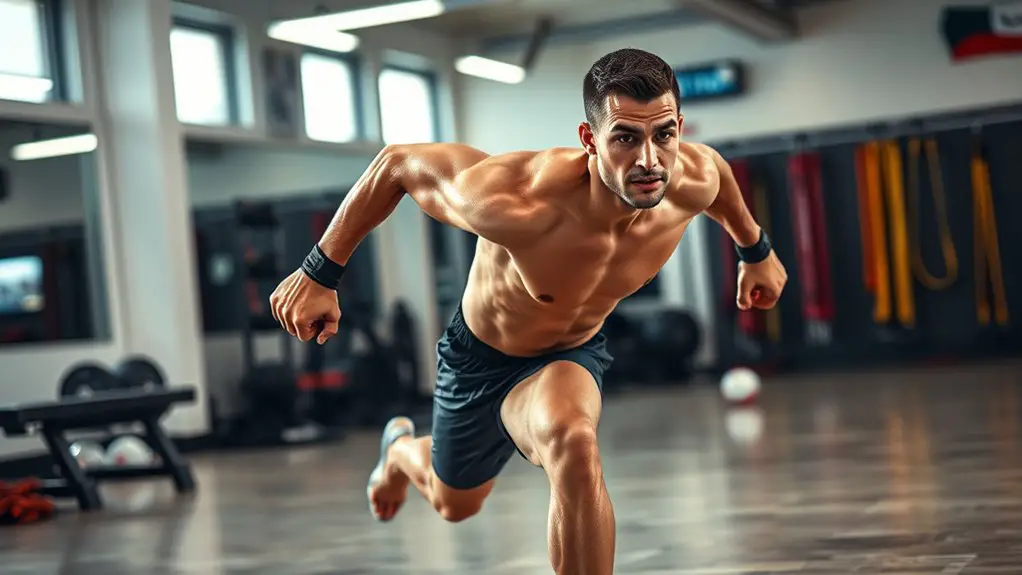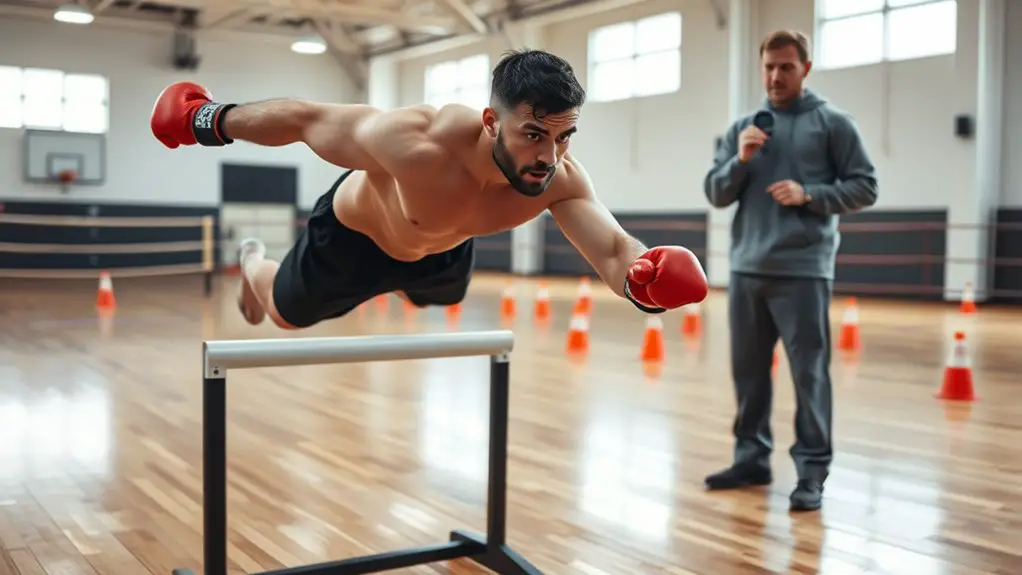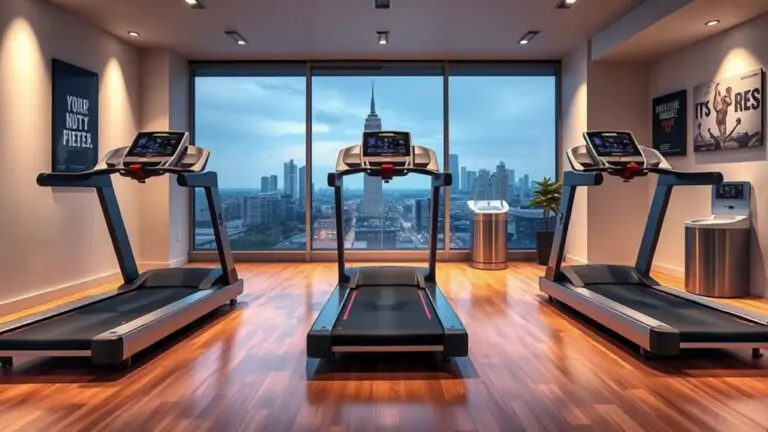How Gym Training Enhances Speed and Agility for Fighters

Effective gym training enhances your speed and agility by improving your overall functional strength, coordination, and balance. Incorporating plyometric exercises, agility drills, and sprint intervals boosts your reaction time and quickness, essential during fights. Additionally, a strong core supports dynamic movements, promoting both stability and explosive power. By developing mental resilience alongside physical skills, you prepare yourself to perform under pressure. There’s much more to discover about optimizing your training for peak performance.
The Importance of Speed and Agility in Combat Sports

When it comes to combat sports, you can’t underestimate the role of speed and agility; these attributes are often the difference between victory and defeat. Speed isn’t just about how fast you can move; it’s about your reaction timing. In the heat of a fight, an opponent’s swift jab can easily catch you off guard. That’s why developing your reflexes is essential. Agility complements speed, allowing you to evade strikes and position yourself effectively.
Incorporating agility drills into your training enhances your fight strategy, enabling you to maintain control over the pace and flow of the match. Whether you’re dodging punches or closing the distance, quick, agile movements can create openings that lead to decisive strikes. By focusing on these elements, you not only boost your performance but also increase your confidence in the ring. Remember, in combat sports, being quick and agile is just as important as strength and technique.
Key Components of Effective Gym Training
To achieve peak performance in combat sports, you must focus on several key components of effective gym training. First and foremost, incorporating functional movements is essential. These exercises mimic real-life actions and enhance your overall athleticism, improving strength, coordination, and balance. Think squats, deadlifts, and kettlebell swings—each movement translates directly to your fighting skills.
Next, don’t overlook dynamic stretching. This prepares your muscles for the intensity of training and helps increase your range of motion. By integrating dynamic stretching into your warm-up routine, you reduce the risk of injuries and improve your agility.
Finally, guarantee your training regimen balances strength, speed, and endurance. This trifecta not only supports your performance in the ring but also builds the resilience needed for prolonged bouts. Additionally, incorporating skipping rope can enhance your cardiovascular fitness and overall agility. Prioritize these components, and you’ll lay a solid foundation for success in your combat sports journey.
Targeted Workouts for Enhancing Speed

While many fighters focus on strength and endurance, enhancing speed is equally essential for gaining an edge in the ring. Targeted workouts can noticeably improve your explosive power and quickness. Incorporating plyometric exercises, such as box jumps and depth jumps, boosts your muscle response time and overall explosiveness. Additionally, sprint intervals—short bursts of high-intensity running followed by rest—train your body to recover quickly while maintaining speed. Jumping rope is also a beneficial exercise that improves cardiovascular endurance and footwork, which are crucial for fighters.
Here’s a simple workout breakdown:
| Exercise | Duration/ Reps | Purpose |
|---|---|---|
| Box Jumps | 3 sets of 10 | Build explosive strength |
| Sprint Intervals | 30 sec on/30 sec off | Enhance speed endurance |
| Depth Jumps | 3 sets of 8 | Improve reactive power |
Agility Drills to Improve Reaction Time
To excel in combat sports, refining your reaction time is essential, and agility drills are a powerful tool for that. Incorporating ladder drills, cone drills, and reaction ball exercises into your training routine can greatly enhance your speed and responsiveness. Each of these drills targets different aspects of agility, ensuring you’re not just quick on your feet, but also ready to react effectively in the heat of competition.
Ladder Drills for Speed
If you’re looking to enhance your speed and agility in the ring, incorporating ladder drills into your training regimen can be a game changer. These drills offer a variety of ladder variations that target your footwork techniques, enabling you to react faster and move more fluidly. By practicing quick steps and lateral movements, you’ll develop muscle memory essential for dodging punches and closing distance with opponents. Start with basic patterns, then progress to more complex sequences to challenge yourself. Consistent practice not only boosts your speed but also improves coordination and balance. As you master these drills, you’ll notice an increased ability to read your opponent’s movements, giving you the edge needed to excel in high-pressure situations.
Cone Drills for Agility
Incorporating cone drills into your training can greatly enhance your agility and reaction time, essential skills for any fighter. By strategically adjusting cone placement and spacing, you can simulate various fight scenarios that require quick, agile movements. Start with a simple layout: place cones in a straight line, then gradually increase complexity by creating zig-zags or T-shapes. Focus on explosive starts and sharp changes in direction, as these mimic the unpredictable nature of combat. As you progress, challenge yourself with quicker footwork and reduced cone spacing to sharpen your reflexes. Remember, the goal is to improve not just speed, but also your ability to react instinctively to an opponent’s movements. Embrace the challenge, and watch your agility soar!
Reaction Ball Exercises
While agility drills like cone exercises are essential for fighters, reaction ball exercises take your training to another level by honing your reflexes and hand-eye coordination. Utilizing reaction ball techniques, you’ll enhance your ability to respond quickly to unexpected movements, simulating real fight scenarios. These exercises challenge your brain to process visual stimuli and engage your body in a swift response, which is vital in combat sports.
The reaction ball benefits extend beyond speed; they improve your overall agility and focus, making you more adaptable in the ring. Incorporating these drills into your routine not only sharpens your reaction time but also builds confidence in your ability to execute techniques under pressure. Embrace this training to elevate your performance!
Strength Training: Building a Foundation for Performance
To excel in combat sports, your training must prioritize core stability, as it’s essential for maintaining balance and power during movement. Incorporating compound movements into your routine not only enhances strength but also mimics the dynamic actions you’ll face in the ring. By focusing on these elements, you’ll build a solid foundation that amplifies your performance and resilience in high-pressure situations. Additionally, engaging in exercises like the Renegade Rows can significantly improve your core strength and overall muscle engagement.
Core Stability Importance
Core stability serves as the bedrock of athletic performance, especially for fighters who rely on explosive movements and precise control. By enhancing your core strength through targeted stability training, you create a solid foundation that supports every strike, block, and maneuver. A strong core not only improves balance and coordination but also enables efficient energy transfer throughout your body during intense bouts. When you engage in stability training, you’re not just building muscle; you’re developing the endurance and resilience needed to withstand the rigors of combat. This focus on core strength allows you to maintain control under pressure, making it essential for maximizing your speed and agility. Invest in your core, and you’ll elevate your overall fighting performance.
Compound Movements Benefits
Building on the foundation of core stability, incorporating compound movements into your strength training regimen can greatly enhance your performance as a fighter. These exercises, like squats and deadlifts, engage multiple muscle groups simultaneously, promoting functional strength that translates directly to your combat skills. By performing compound movements, you improve your overall power, coordination, and balance, essential attributes for speed and agility in the ring. Additionally, they stimulate greater hormonal responses, leading to better muscle growth and endurance. This holistic approach to strength training not only builds a solid foundation but also prepares your body for the dynamic demands of fighting. So, prioritize compound movements to elevate your athletic performance and outmaneuver your opponents effectively.
The Role of Stamina and Resilience in Competitive Fighting

While many factors contribute to success in competitive fighting, stamina and resilience stand out as vital attributes that can make or break an athlete in the ring. Stamina training enhances your endurance, allowing you to maintain peak performance throughout intense bouts. It’s not just about physical fitness; it’s about pushing through the fatigue while maintaining technique and focus.
Mental resilience plays a significant role too. When the pressure mounts, your ability to stay composed can determine the outcome. Visualize the fight and prepare yourself for adversity—both physically and mentally. Embrace challenges during training to build this resilience, as it’ll serve you well when facing an opponent who’s equally skilled.
Combining stamina training with mental fortitude equips you to handle the grind of competition. Remember, the fight isn’t just in the body; it’s in the mind. Stay committed, and you’ll rise to the occasion when it matters most.
Frequently Asked Questions
How Often Should Fighters Train for Speed and Agility?
To optimize your speed and agility, consider training frequency and workout intensity. It’s essential to find a balance—aim for at least three to four sessions a week, focusing on explosive movements and quick drills. Intensity matters; incorporate high-intensity interval training to push your limits. Listen to your body, ensuring adequate recovery to prevent burnout. Consistent, targeted training will enhance your performance and keep you competing at your best. Keep pushing your boundaries!
Can Yoga Improve Speed and Agility for Fighters?
You might think yoga’s all about relaxation, but it can actually do wonders for your speed and agility. By incorporating specific yoga poses, you’ll boost your flexibility benefits, allowing for quicker movements and better balance. Improved flexibility helps prevent injuries, keeping you in the ring longer. So, while some may overlook yoga as a serious training method, it’s a powerful tool that can enhance your overall performance and agility as a fighter.
What Nutrition Supports Speed and Agility Training?
When it comes to nutrition for speed and agility training, carbohydrate timing is essential. Consuming complex carbs before workouts fuels your energy levels, while fast-digesting carbs post-training aids recovery. You shouldn’t overlook protein sources either; lean meats, eggs, and legumes help repair muscle tissue. Balancing these nutrients not only enhances your performance but also strengthens your body for rigorous training sessions. So, prioritize your nutrition to maximize your agility and speed gains!
Are There Specific Warm-Ups for Speed and Agility?
Yes, there are specific warm-ups that focus on enhancing speed and agility. Incorporating dynamic stretches is essential; they prepare your muscles and joints for explosive movements. Pair these with agility drills like ladder exercises or cone sprints to sharpen your footwork and reaction time. These warm-ups not only reduce injury risk but also activate your nervous system, ensuring you’re primed for intense training. Commit to this routine, and you’ll see significant improvements in your performance.
How Can Mental Training Enhance Physical Agility?
Mental training can greatly enhance your physical agility. By incorporating mindfulness techniques, you’ll become more aware of your body’s movements, allowing for quicker reactions. Visualization exercises enable you to mentally rehearse complex movements, improving coordination and efficiency. When you focus on these mental aspects, you’re not just preparing your body; you’re sharpening your mind, leading to more fluid shifts and enhanced performance. Embrace this dual approach for maximum agility improvement.





